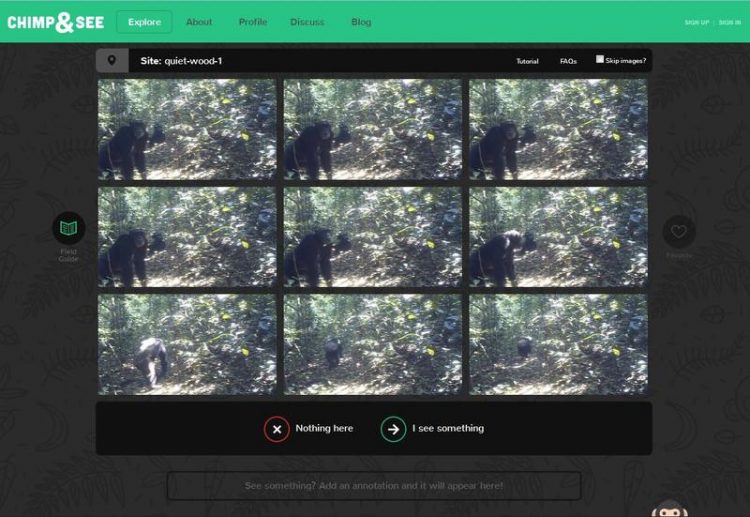Participation sought: new citizen science project

Screenshot Chimp&See chimpandsee.org
In celebration of Earth Day on 22 April, a special citizen science project is being launched online in the form of Chimp&See. The platform http://www.chimpandsee.org brings amateur researchers together with scientists and shows the general public just how exciting research can be.
Citizen scientists, as these members of the public are called, can make an invaluable contribution to the study of chimpanzees and other animals in the wild; no previous knowledge is necessary. The amateur researchers simply watch the short clips uploaded to the online platform and name any animals which have been captured by the automatically triggered cameras in the African wilderness. Forest buffalo, duiker or pangolin – describing the animals is not always an easy task.
A digital guide containing reference photos helps the citizen scientists name the animal while also providing fascinating background information. Anyone lucky enough to be the first person to discover a chimpanzee on a video clip can even give it a name.
Chimp&See is based on an effective principle: the higher the number of volunteers participating and providing data on the clips, the greater the hit and description ratio. The sightings will later be evaluated by scientists and collated with the list of animals which have already been identified by other helpers. An open forum also allows volunteers to discuss the project among themselves or to contact experts.
Christophe Boesch, Director at the Max Planck Institute for Evolutionary Anthropology in Leipzig, hopes that the citizen science initiative will give rise to key momentum in primate research. “With the help of enthusiastic and engaged citizen scientists, this exciting project has the potential to change our understanding of wild chimpanzee ecology”, says the behavioural scientist.
Using the analysed data, the experts are looking to draw conclusions on, for example, the spread of prey in the areas examined, any human threat, how the biological and genetic diversity is presented in the biotope and whether some habitats are preferred over others by certain animals.
The research also focuses on the use of tools, which plays a major role for chimpanzees. “We want to find out more about how the primates specifically use tools”, says Hjalmar Kühl, head of the research group “Sustainability and Complexity in Ape Habitat” at the German Centre for Integrative Biodiversity Research (iDiv).
Kühl explains that long-term studies have already shown that chimpanzees use their tools in different ways, even for the same mechanisms involved in catching their prey. Experts are yet to discover how and why this variance has developed.
Anyone interested in the project can take part in Chimp&See. During the start-up phase, around 200,000 videos will be hosted on the online platform, split up into sequences of around 15 seconds each. A further 200,000 clips are planned to be added in the future. The citizen science project will be online until 2017.
Platforms
Chimp&See: http://www.chimpandsee.org
Zooniverse: http://www.zooniverse.org/
Pan African Programme: http://panafrican.eva.mpg.de/
More Information:
Prof. Christophe Boesch
Max Planck Institute for Evolutionary Anthropology
Phone: +49 (0) 341 3550 200
E-Mail: boesch@eva.mpg.de
Dr. Hjalmar Kühl
German Centre for Integrative Biodiversity Research (iDiv) Halle-Jena-Leipzig
Phone: +49 (0) 341 9733 147
E-Mail: hjalmar.kuehl@idiv.de
Press Contact:
Annette Mihatsch
German Centre for Integrative Biodiversity Research (iDiv) Halle-Jena-Leipzig
Phone: +49 (0) 341 9733106
E-Mail: presse@idiv.de
Sandra Jacob
Max Planck Institute for Evolutionary Anthropology
Phone: +49 (0) 341 3550-122
E-Mail:info@eva.mpg.de
Media Contact
More Information:
http://www.idiv.de/All latest news from the category: Life Sciences and Chemistry
Articles and reports from the Life Sciences and chemistry area deal with applied and basic research into modern biology, chemistry and human medicine.
Valuable information can be found on a range of life sciences fields including bacteriology, biochemistry, bionics, bioinformatics, biophysics, biotechnology, genetics, geobotany, human biology, marine biology, microbiology, molecular biology, cellular biology, zoology, bioinorganic chemistry, microchemistry and environmental chemistry.
Newest articles

Superradiant atoms could push the boundaries of how precisely time can be measured
Superradiant atoms can help us measure time more precisely than ever. In a new study, researchers from the University of Copenhagen present a new method for measuring the time interval,…

Ion thermoelectric conversion devices for near room temperature
The electrode sheet of the thermoelectric device consists of ionic hydrogel, which is sandwiched between the electrodes to form, and the Prussian blue on the electrode undergoes a redox reaction…

Zap Energy achieves 37-million-degree temperatures in a compact device
New publication reports record electron temperatures for a small-scale, sheared-flow-stabilized Z-pinch fusion device. In the nine decades since humans first produced fusion reactions, only a few fusion technologies have demonstrated…





















